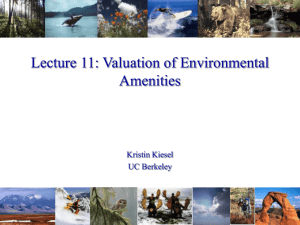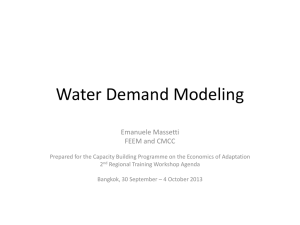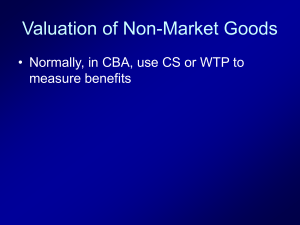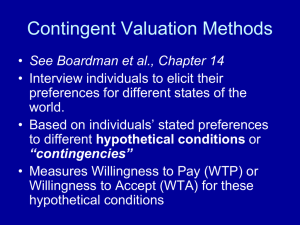Chapter #9: Valuation of Environmental Benefits
advertisement
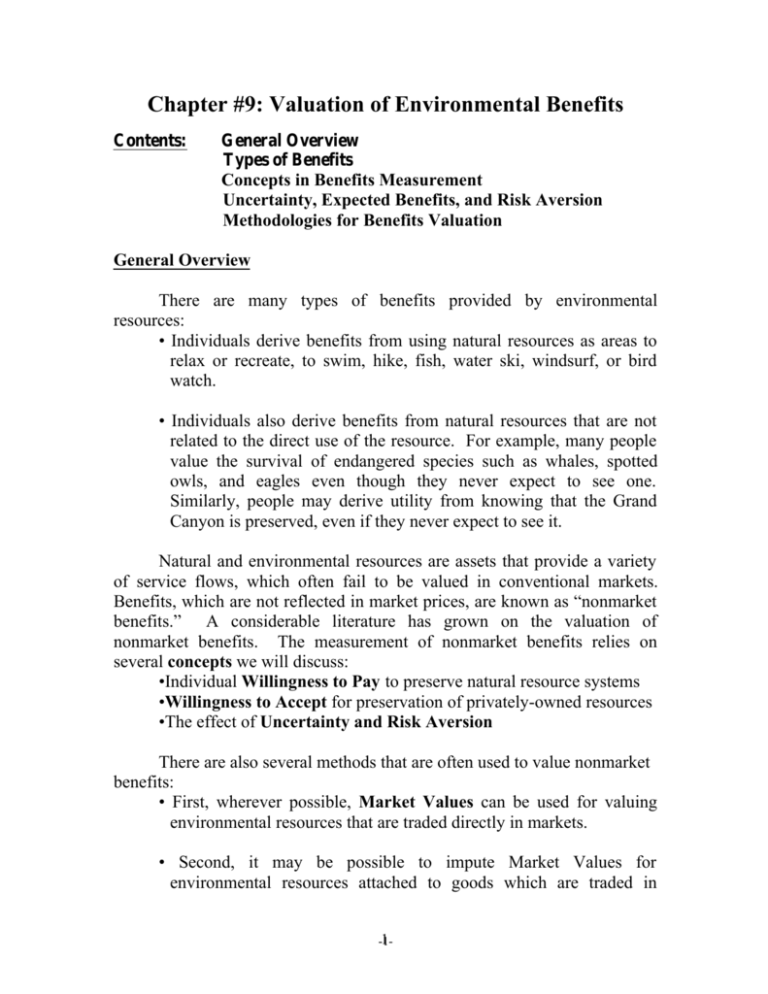
Chapter #9: Valuation of Environmental Benefits Contents: General Overview Types of Benefits Concepts in Benefits Measurement Uncertainty, Expected Benefits, and Risk Aversion Methodologies for Benefits Valuation General Overview There are many types of benefits provided by environmental resources: • Individuals derive benefits from using natural resources as areas to relax or recreate, to swim, hike, fish, water ski, windsurf, or bird watch. • Individuals also derive benefits from natural resources that are not related to the direct use of the resource. For example, many people value the survival of endangered species such as whales, spotted owls, and eagles even though they never expect to see one. Similarly, people may derive utility from knowing that the Grand Canyon is preserved, even if they never expect to see it. Natural and environmental resources are assets that provide a variety of service flows, which often fail to be valued in conventional markets. Benefits, which are not reflected in market prices, are known as “nonmarket benefits.” A considerable literature has grown on the valuation of nonmarket benefits. The measurement of nonmarket benefits relies on several concepts we will discuss: •Individual Willingness to Pay to preserve natural resource systems •Willingness to Accept for preservation of privately-owned resources •The effect of Uncertainty and Risk Aversion There are also several methods that are often used to value nonmarket benefits: • First, wherever possible, Market Values can be used for valuing environmental resources that are traded directly in markets. • Second, it may be possible to impute Market Values for environmental resources attached to goods which are traded in 1 -1- markets. This is often referred to as the technique of Hedonic Pricing. For example, property values in certain areas might capitalize air and water quality into housing prices. • Third, there are Travel Cost Models, which infer resource values based on the opportunity cost of time and travel to visit areas such as Yosemite Park. • Fourth, there are Engineering and Agronomical Cost Methods, which calculate value based on the cost of restoring a developed natural resource. • The final major methodology is the Interviewing Technique. The interviewing technique, or Contingent Valuation Method (CVM), elicits nonmarket values by asking people directly to state their valuation of a resource. Types of Benefits Use Benefits Use Benefits refer to the utility arising from direct or indirect physical use of a resource including commercial use, recreational use, and aesthetic use. There are two subcategories of Use Benefits: • Consumptive Use Benefits are private benefits that are derived from resource consumption. Consumptive Use Benefits contribute to resource depletion. Examples are farming, forestry, fishing, grazing, hunting, mining. • Nonconsumptive Use Benefits are generally public good benefits. Nonconsumptive Use Benefits do not contribute to resource depletion. Examples are swimming, boating, hiking, camping, viewing wildlife, observing scenic forests, mountains, rivers, waterfalls, etc. Nonuse Benefits Nonuse benefits refer to utility that is derived from environmental resources without physical interaction with the resource. There are several subcategories: • Option Value Benefits arise in situations where depleting a resource is an irreversible action. For example, when large areas of rainforest 2 -2- are slashed and burned, unknown/undiscovered species of plants, insects, and animals may become extinct. Some of these plants, for example, may hold important medicinal value that we will now never know about. An Option Value Benefit is a benefit, which is derived from maintaining the option to utilize future, unknown benefits by avoiding or delaying irreversible actions. • Vicarious Consumption Benefits refers to utility derived from the consumption of environmental resources by other individuals. That is, you may derive utility when your friends visit Manhattan from their enjoyment of Tuttle Creek Lake, since this makes you feel like a good host. • Stewardship Benefits are moral benefits that we derive from knowing that we are doing our parts as stewards of the worlds’ resources. There are two types of Stewardship Benefits: - Bequest Benefits refer to utility derived from passing an environmental resource on to children and/or future generations. - Existence Value, or Inherent Benefits refer to utility derived from the knowledge of the mere existence of environmental resources. Recall that efficient markets equate marginal social benefits with marginal social costs (including any external costs, etc.). When market prices equal both MSB and MSC, then government intervention in the market may not be necessary to achieve Pareto efficiency. These conditions may hold for certain types of consumptive use benefits. However, many non-consumptive use benefits and most nonuse benefits are not reflected in market prices. This situation is a potential source of market failure. Certain consumptive use benefits may not be priced correctly, as we will see, due to open access of the resource. Non-consumptive use benefits may not be reflected in market prices, because associated environmental resources have characteristics of public goods. Nonuse benefits may not be reflected in market prices because markets may not exist for such benefits. 3 -3- Concepts in Benefits Measurement Willingness to pay (WTP) WTP is the maximum amount of money an individual would give up in exchange for all the benefits associated with an environmental resource. It is the valuation placed on an environmental good in terms of money. We can think of WTP as the area under an individual’s demand curve. That is, an individual can be said to be willing to pay an amount equal to the total benefits received from the environmental good. Willingness to accept (WTA) WTA is the opposite of WTP. It holds in the case in which the individual is the owner of the resource. WTA is the minimum total amount of money an individual would accept to forego all the benefits associated with an environmental resource. Since, WTP is bounded by an individual’s budget constraint we can assume: WTP < WTA Uncertainty, Expected Benefits, and Risk Aversion We are often uncertain about the benefits of preserving environmental resources, the benefits from improving the state of environmental resources, and the costs associated with depleting and degrading environmental resources. In general, uncertainty refers to the existence of several possible outcomes for a given decision. Note that a decision is a choice between several alternative courses of action and that one of these choices may be to take no action at all. If we can attach some sort of probability to the occurrence of each outcome, then we can calculate the Expected Benefit/Cost associated with each course of action. The Expected Benefit/Cost of a course of action is the sum of the Benefits/Costs associated with each possible outcome, multiplied by the probability that the outcome will occur if the course of action is chosen. 4 -4- As an example, suppose you like to gamble and a friend asks you to bet on the outcome of a coin toss. Suppose he is willing to pay you $100 if you choose correctly, but will take $65 from you, if you choose incorrectly. You can evaluate this opportunity by calculating the expected benefit, E(B), of the bet and comparing it to the certain cost of $65: E(B) = .5(0) + .5($100) = $50 Therefore, you conclude the following: 1) this is a bad bet 2) this is a bad friend An Environmental Resource Example Suppose the Department of Fish and Wildlife is considering a management project that improves fish habitat in a trout-fishing stream, say Tuttle Creek. The possible courses of action are (1) don't do the project (i.e., take no action), or (2) do the project. Suppose that the outcome under no action is certain and equal to "Status Quo Benefit,” and that the outcome from doing the project is uncertain, since there are three possible outcomes. Suppose the Department can attach a rough probability to each outcome under the project: Probability: 1/2 1/4 1/4 Possible Outcome Under the Project: Status Quo Benefit + $6M. Status Quo Benefit + $3M. Status Quo Benefit + $9M Then the Expected Benefits associated with each course of action would be: • Expected Benefit of no action = Status Quo Benefit • Expected Benefit with project: = Status Quo Benefit + 1/2 · $6M + 1/4 · $3M + 1/4 · $9M = Status Quo Benefit + $6M. If the effect of uncertainty is to make the Department willing to pay less than the Expected Benefit of the project to undergo construction, then we say that the Department is Risk Averse. That is, a Risk Averse Department has WTP < $6M. 5 -5- The difference between the Expected Benefits of the project and the most the Department would be willing to pay is called the Risk Premium. The Risk Premium measures the Department’s aversion to risk and uncertainty. If the Department has WTP = $5M, then the Risk Premium on the project is $1M. Methodologies for Benefits Valuation Market Values The use of market prices to value traded resources is the best method when there is no market failure. However, this approach is difficult to implement for environmental resources for two reasons: • Market Failure often occurs in providing environmental resources due to externalities, and • Many environmental resources are not traded in markets. Hedonic Pricing Natural resources can be thought of as bundles of characteristics, such as recreational characteristics, consumptive characteristics, and aesthetic appeal. These characteristics vary in type and in quality across resources. In this framework, the price of a resource reflects various combinations of characteristics as well as various levels of quality. Pollution may reduce the quality of some characteristics of an environmental resource and environmental regulation may enhance them. Hedonic Pricing is a method of analysis used to assess the marginal value of a characteristic. In many instances, Hedonic Prices of a characteristic such as natural resource quality can be deduced from market prices using statistical analysis and econometric techniques. In order to perform statistical analysis, data on market prices and quality levels of important resource characteristics are collected, then the function that best fits the data is used to estimate the Hedonic Prices of the natural resource characteristics. Say we wish to estimate the aesthetic benefit of a beautiful view of the Pacific Ocean in Big Sur. It is possible that such aesthetic value is capitalized into the relative price of ocean-side property compared with other property that does not overlook the Pacific. We may be able to use market data for houses in the community to derive the value of a house as a function of several housing characteristics, such as: •House Size 6 -6- •Lot Size •Location (e.g., distance of house from center of employment, shopping) •Scenic View (i.e., whether or not the house has a view of the Pacific). We can derive the marginal value associated with each characteristic by formulating an econometric model in which the endogenous variable, House Price, is related to these four exogenous characteristics. In this context, the coefficients on the exogenous variables in the model can be interpreted as the marginal values of the characteristics. We then use statistical regression analysis to parameterize the marginal value of each characteristic that best fits our market data. For example, we might hypothesize that House Price depends on the four housing characteristics in the following way: House Price = n + n1 (Distance) + n2 (House Size) + n3 (Lot Size) + n4 (View) where parameters n1 , n2 , n3 , and n4 represent: n1 = the marginal value of a unit of distance n2 = the marginal value of a unit of house size n3 = the marginal value of a unit of lot size n4 = the marginal value of having a scenic view Notice in our equation that the derivative of House Price with respect to Distance is "n1 ". Hence, "n1 " represents the marginal value of a unit of distance. Similar interpretations can be made for the other parameters in the model. Now, suppose we have data on House Prices, Distance to town, House Sizes, Lot Sizes and can delineate houses which have a Scenic View. We can then use statistical regression analysis to estimate the marginal values for the parameters that give our hypothesized equation the best fit to the data. We can also run some standard goodness-of-fit tests to determine how well our hypothesized equation fits the data. Based on the results of these tests, we may decide that our hypothesized model does not fit the data very well. If that were the case, we might hypothesize a different equation, do another statistical regression analysis, test it, and so on until we find an equation that fits the data well (this is what economists are often paid to do). 7 -7- For the purposes of this discussion, let's assume that the equation we hypothesized above fits the data relatively well. Then, one of the results from our statistical regression analysis is a set of marginal values for n1 , n 2 , n3 and n4 in our equation that best fit the data. Suppose, for example, that the results of our statistical regression analysis are (in thousands of dollars): n1 = -20 = the marginal value of a unit of distance n2 = 80 = the marginal value of a unit of house size n3 = 10 = the marginal value of a unit of lot size n 4 = 30 = the marginal value of having a view One way to present our data is in Figure 8.1. The figure presents data on house prices with and without a view. The two lines are the estimated Hedonic Price equations, denoting prices as a function of house size, holding distance and lot size constant. Here we find that for a given house size, people are willing to pay a premium of $30,000 for an aesthetic view of the lake, i.e., the equation relating House Price to House Size is shifted up by 30 for houses with a view. Figure 9.1 Travel Cost Methods Many recreational amenities are not purchased in markets so their value must be inferred from associated expenditures. For example, the value of a recreational facility, say, boating at a lake, can be measured by the opportunity cost of time and travel cost spent on the way to the lake, as well as on physical expenses such as gasoline. For example, assume there is one lake in a region, Lake Tahoe. It attracts 40,000 visitors/month. Each visitor spends 5 hours boating and 2 hours traveling. The opportunity cost of time is $8/hr for every individual. 8 -8- Gas and car use cost $6/travel hour per visitor. Entry cost is $2/visit. Thus, the total travel cost is: 40,000 * [8 * 7 + 6 * 2 + 2] = 40,000 * 70 = $2,800,000. The $2.8 million per month is an estimate of a lower bound on WTP for recreational benefits from the lake. It is a lower bound, because anyone that finds it optimal to spend time at the lake must receive at least enough benefit to cover the travel cost of getting to the lake, but might receive considerably more. The travel cost method may be used in assessing the lost recreational value resulting from closure of the lake, if, say, an oil spill or excessive pollution from agricultural runoff causes the lake to close due to public health concerns. If there are other substitute lakes, for example, Mono Lake, travel cost methods become more complex. If there are three lakes, A, B, and C, closure of A will cause some people to use B and C. However, B and C will be more congested and the benefits of using them will decline. Thus, we need to understand patterns of use of A, B, and C to assess their benefits and the impact of congestion on benefits. Engineering and Agronomical Cost Methods In the case of natural resources that can be restored (e.g. forests, wetlands, etc.), engineering and agronomical techniques using mathematical programming can be used to estimate the cost of restoration. However, the relationship between restoration cost and resource value may not be well established. Some environmental resources may be of little value and be uneconomical to restore, while, for other resources, restoration costs may provide a lower bound on the true social value of the resource. Interviewing Techniques: Contingent Valuation Method (CVM) Currently, there is no other way to elicit nonmarket values besides asking people directly: • How much would you be WTP for an amenity? • How much would you be WTA to forego an amenity? • How would you vote for a proposition involving an environmental or resource use choice? 9 -9- Obviously, simply responding to a survey question conveys less information about benefits and costs than does an actual market purchase, as individuals are never actually required to engage in the transaction. In situations where people face such hypothetical costs and benefits, they may not have sufficient incentive to seriously consider their responses to survey questions. Such individuals may not approximate the “rational individual” assumed in economic models. The major problems with Interviewing Techniques include: • Strategic Bias (Not telling the truth): Talk is cheap. Individuals may report benefits higher or lower than their true benefits in order to advance their own agenda or to hinder the agenda of someone else. • Framing Bias: People's answers may vary according to the context in which a question is put. For example, answers to a WTP question may differ depending on whether the starting point of the initial value is zero or $100. For example… start: $0 or start: $100 response: $10 response: $110 • Ill-formed Preferences: People may not have well-formed preferences (e.g., WTP and WTA) for unfamiliar goods (e.g., a native of Kansas may not have well-formed preferences for an endangered fish in Florida that the Kansas had never heard of before the C.V. survey). • Information Bias: Failure to comprehend or to interpret questions correctly. People are limited in their capacity to process, analyze, and retain information. For example, people may infer that an issue is important (and thus have positive WTP) simply because they receive information from a survey, but may have had zero WTP beforehand. Some General Methodological Considerations The role of information in valuing environmental resources is important in a broader sense as well. Since we are only experiencing life in a small range of history, we may lack an adequate perspective of the true benefits of environmental preservation. Whether we are using values based on market transactions or derived from a survey, these values are not static, but can only represent values based on information available at the time. In the future, pollution and the loss of wildlife habitat are likely to effect us in 10 -10- ways we do not currently understand. Only as time progresses will we find out the true value of preserving natural environments. 11 -11-
